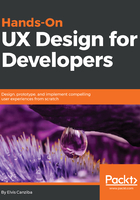
Full stack design
Since we now understand what UX stands for, it's time to dive deeper into a trending topic that is getting a lot public attention, the full stack design.
As an example, let's look at designing a new logo. Usually, a graphic designer will create a bundle of graphical elements to give a better presentation to their client. For example, they will include the good and bad practices of logo use, negative logos, how it can be used in horizontal, and vertical space, favicons, and so on.
The idea of web frameworks, such as Bootstrap, Foundation even Google's Material Design guidelines, is similar; just like a graphic designer who has to provide all the rules, guides, and best practices of use for a logo that they created, the full stack designer provides web style guides, animations, graphical assets, interactions, and UI elements that will be used across the platform.
Today, a lot of companies, even larger ones, have built their own custom design frameworks to keep track of their product's UI.
So, creating this kind of framework, from A to Z, from the UX Research process to the final UI components that represent the core of your product concepts on many areas, I call this the full stack design process.